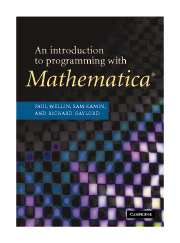Book contents
- Frontmatter
- 1 An introduction to Mathematica
- 2 The Mathematica language
- 3 Lists
- 4 Functional programming
- 5 Procedural programming
- 6 Rule-based programming
- 7 Recursion
- 8 Numerics
- 9 Graphics programming
- 10 Front end programming
- 11 Examples and applications
- 12 Writing packages
- Appendix A How expressions are evaluated
- Appendix B Debugging
- References
- Solutions to exercises
- Index
11 - Examples and applications
Published online by Cambridge University Press: 21 March 2011
- Frontmatter
- 1 An introduction to Mathematica
- 2 The Mathematica language
- 3 Lists
- 4 Functional programming
- 5 Procedural programming
- 6 Rule-based programming
- 7 Recursion
- 8 Numerics
- 9 Graphics programming
- 10 Front end programming
- 11 Examples and applications
- 12 Writing packages
- Appendix A How expressions are evaluated
- Appendix B Debugging
- References
- Solutions to exercises
- Index
Summary
The development of larger-scale Mathematica programming projects is discussed and illustrated in this chapter. Each of the examples in this chapter contain numerous tasks that need to work together and also integrate well with Mathematica. When you develop such applications, it is important to think about how your functions work with each other as well as how well they integrate with the rest of Mathematica. The user's interface to your programs should be as close as possible to the built-in functions of Mathematica so that users can more easily learn the syntax and usage. Features such as options, argument checking, messaging, and documentation are all discussed in the context of larger applications that are developed using all of the tools that were developed in earlier chapters.
Manipulating data files
Introduction
One of the most common tasks for scientists and engineers is working with data sets that have been generated by some external process or collector. If they are lucky, the data are stored in a file that has a standard format and can then be read into other programs such as Mathematica with ease using that program's importing functionality. Oftentimes, however, data are stored in files with nonstandard formats and reading that file into a program such as Mathematica requires some manual processing of that file to extract the required parts.
In this section we will walk through the steps of reading, manipulating, and visualizing a dataset that consists of solar radiation data collected by the Renewable Resource Data Center, an organization that is managed by the US Department of Energy (interested readers should visit rredc.nrel.gov).
- Type
- Chapter
- Information
- An Introduction to Programming with Mathematica® , pp. 341 - 394Publisher: Cambridge University PressPrint publication year: 2005

